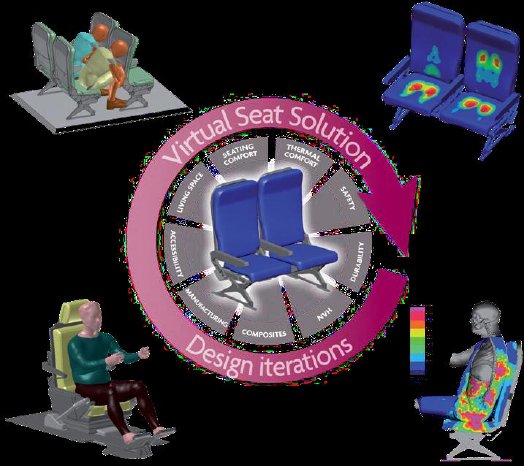In the highly competitive business of civil aviation, seats are a key element for airlines to maximize revenue by optimizing payload. Seats also embody an airline's differentiation strategy: they are the flagship component in the cabin and a means to entice and retain customers. Having the right seats represents a true competitive advantage and consequentially aircraft seats are of growing importance. This is well illustrated by the action of Air France, which is currently upgrading its long-haul fleet and will add 10,000 new economy class seats aboard 44 aircraft between June 2014 and July 2016.
Aside from the need to meet passengers' growing expectations in terms of comfort, future aircraft seats will have to answer challenges linked to weight reduction as a means to enable airlines to save substantial amounts of fuel. This must be achieved without negative impact on passenger safety and in compliance with evolving safety regulations. Future aircraft seats will need to be lighter, more comfortable, and also allow new in-flight activities (including phone calls, internet use, medical care...).
Furthermore seats must be adapted to the changing morphology of passengers, as our population ages and increases in size and weight. Seat designers and manufacturers must now cater to all types of passengers, whatever their age, weight or disability.
To speed up the research for solutions offering an optimal balance between passenger comfort, seat weight and morphological variations, Zodiac Seats France is leading the project "Passenger Seats of the Future". The laboratory LAMIH, UMR 8201 CNRS from the University of Valenciennes and Hainaut-Cambrésis is taking part in the project along with the laboratory LBMC, UMR-T 9406 from IFSTTAR and from the University Claude Bernard Lyon 1. On the industrial front, Texisense, a French company specialized in hi-tech sensors, and ESI have joined with several subsidiaries from the Zodiac Group: Zodiac Aerotechnics, Zodiac Aerosafety Systems and Zodiac Actuation systems.
ESI brings to this project a wealth of experience in Virtual Prototyping and seat comfort prediction - addressing static seating comfort, thermal comfort, and vibration absorption during different phases of a flight, and for all populations.
This experience is embodied in ESI's software Virtual Seat Solution, which is dedicated to the virtual design, manufacturing and prediction of seat performance and takes into account material physics, manufacturing processes and the behavior of a human body for all morphologies. Thanks to its unique precision, Virtual Seat Solution enables the creation of virtual seat prototypes and the evaluation of seat performance right from the early phases of design. Virtual Seat Solution empowers seat specialists to quickly explore different innovative designs at an affordable cost, and ultimately to pre-certify these designs before a physical prototype is ever produced.
For more information about Virtual Seat Solution, please visit http://www.esi-group.com/... For more ESI news, visit: www.esi-group.com/press


